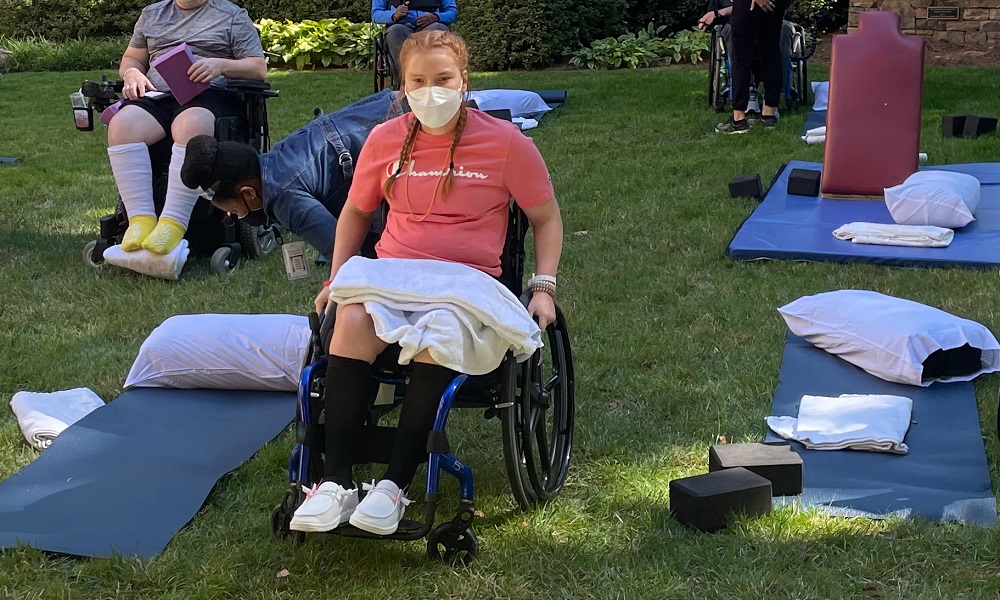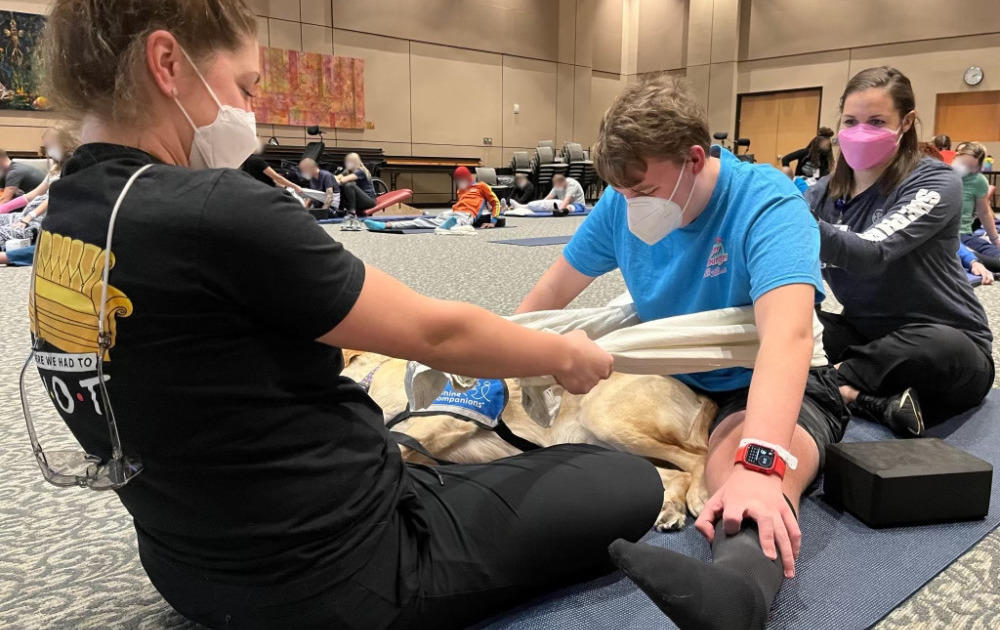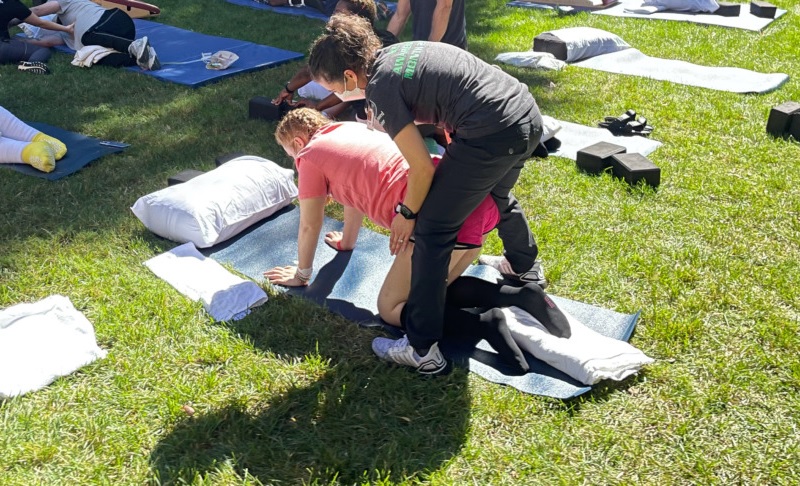After a four-wheeler accident left her paralyzed, Angel Taylor was struggling.
 The then-14-year-old was lonely, in pain and still adjusting to maneuvering in a wheelchair when she started her rehabilitation in summer 2020 at the Shepherd Center. An occupational therapist at that brain and spinal-cord injury rehabilitation center in Atlanta, Katie Kimball, urged the girl to join other teenagers with similar injuries in a class combining yoga, meditation, music, breathing exercises and sunlight.
The then-14-year-old was lonely, in pain and still adjusting to maneuvering in a wheelchair when she started her rehabilitation in summer 2020 at the Shepherd Center. An occupational therapist at that brain and spinal-cord injury rehabilitation center in Atlanta, Katie Kimball, urged the girl to join other teenagers with similar injuries in a class combining yoga, meditation, music, breathing exercises and sunlight.
Weeks later, the movement and breathwork of what’s known as adaptive yoga, along with physical therapy, made Taylor’s body feel freer, more supple. The stretches she practiced, steadily getting better at them, reduced her back pain and that, in turn, majorly boosted her confidence.
“Because, when I first got there, I didn’t have none at all,” the now 16-year-old Hazelhurst, Ga., resident said about her self-esteem. “Because, like, I didn’t know anybody or I wasn’t used to being in wheelchair. But then, once when I got around everybody and I realized we were all in the same boat, I realized that there’s no reason to be scared or insecure about it.”
Aiming to improve body and mind
Like many adolescents and young adults with disabilities, Taylor, whose injury to the ninth of 12 major nerves in the mid-spine typically results in paralysis of the lower body, deals with chronic pain.

Courtesy of Shepherd Center
Practicing adaptive yoga has turned Angela Taylor into a fan of that alternative therapy.
While physical therapy and medications can help, such alternative therapies as adaptive yoga give practitioners with disabilities opportunities to socialize, build confidence and build strength. Its additional muscular and other health benefits have been backed by the Centers for Disease Control and Prevention. A study, enrolling six people and published in Physiotherapy Theory and Practice in 2020, concluded that the social environments created by adaptive yoga held “potential strategies for success in other community programs for those with disability.”
Adaptive yoga instructors Annie Okerlin and Vanessa Weikel said they’ve seen firsthand how its helped youth and those in their 20s optimally manage their disabilities.
Okerlin teaches those whose injuries range from amputations to damaged spinal cords, post-traumatic stress disorder to depression. A Tampa, Fla., adaptive yogi also certified in the relaxation-focused yoga nidra, the 20-year instructor says adaptive yoga helps stretch hip and shoulder joints, promotes circulation by getting the legs higher than the hips and otherwise, in yogi parlance, “opens the body.”
In her classes, those with disabilities use foam blocks, or bolsters, that look like giant Tic-Tacs. They help the legs and the back feel less heavy and release tension from back and belly muscles.
Adaptive yoga supports weakened respiratory system by focusing on the breath and calming the mind. According to a 2007 article in The Journal of Spinal Cord Medicine, those who have spinal-cord injuries often have respiratory system impairments. And Okerlin says adaptive yoga helps broaden lung capacity and ribcage flexibility.
There are about 100 yoga breathing practices and she teaches five to six each practice, Okerlin added. Among the most common is ujjayi, inhaling and exhaling to the count of four or whatever number a person is most comfortable with. Another common technique that Okerlin employs is viloma, in which participants inhale enough air to partially, then, fully fill the lungs; hold their breath; then, exhale. That expands lung capacity, ability to hold ones breath for an extended period and to exhale smoothly, steadily. Lessening anxiety is an additional benefit.
“When you take control of the breath, you take control of the nervous system. And that’s when things get really interesting,” Okerlin said. “It is a great way to empower someone to balance their nervous system, which helps relieve stress, helps them calm down from being overstimulated or anxious or angry.”
Vanessa Weikel, a clinical exercise specialist at Craig Hospital in Englewood, Colo., said the physical practice and breathwork are intertwined.
Weikel likes keeping people on the mat as much as possible, largely because of the exercise equipment she uses. Participants place foam wedges behind them as a precaution: if they push themselves near or past their limits, that wedge will catch them if they fall. She also puts exercise balls between them and the wall to help those with disabilities support and elongate their spines, aiming to strengthen their posture. Some of them can stand, usually with someone’s assistance. While in those postures, participants self-check how they feel mentally and physically, before beginning the breathwork they’ll continue throughout that yoga session.
“So, the science is just very supportive of using breathwork to calm the body and get out of that constant fight-or-flight response that so many people find themselves stuck in a lot of time, which is something that leads to a lot of chronic illnesses,” Weikel said. “I even had a student say that when she was able to use her breathwork and be in control of her breath, she felt like it really helped her spasticity management.”]
Okerlin also recommends adaptive yoga as a supplement for wheelchair users’ physical therapy. Since a wheelchair user’s body is forward-bending— lengthening the back muscles but shortening the front muscles — adaptive yoga helps that person open up the chest, get out of that C-shaped position, stretch and, ultimately, be in better overall health.
“Every human being needs flexibility, and flexibility is going to create more comfort,” Okerlin said. “ … A lot of people look at injury and think, ‘Oh, I’m just going to be in pain or uncomfortable my whole life.’ One of the reasons yoga is so wonderful is because it can be incredibly gentle and still be creating a sense of strength and comfort the whole way through.”
Keeping things light and recreational
Adaptive yoga also is intended to be fun.
Amid the COVID-19 pandemic, Kimball started an adaptive yoga class in a garden at Shepherd Center. Now conducted inside Shepherd’s auditorium biweekly, it enrolls 50 people, including 15 to 25 youth with disabilities, the center’s recreation therapists and staffers who shuttle clients from one floor of the center to the next. It began with all male participants who nicknamed it “bro-ga,” deleting the “yo” from yoga, but later enrolled females, too.
For each two-hour yoga session, which includes time for floor transfers and set-up, there’s a theme — a recent session was “cro-ga” or country yoga — and participants and therapists suggest pre-selected songs to play over a Bluetooth speaker.
Participants start on their backs and go into breathwork and grounding exercises before moving on to hip circles, twists and other warm-up stretches. After that, they perform a sun salutation breath-to-movement sequence. Next, they do a vinyasa, or flow yoga, before cooling down with one additional pose, like a wide-leg forward-fold over a bolster. Finally, they return to their backs to do another leg-sequence pose, like a supine twist.
Caleb Struble, an 18-year-old Palm Coast, Fla., resident, loved doing adaptive yoga while rehabbing at Shepherd.
“After I started doing it for a little bit, I started getting more movement in my legs,” said Struble, whose quadriplegia happened in 2020, when he dove into a sandbar during a lifeguard demonstration. “And I think I can give the adaptive yoga some credit. It makes you more flexible, and you’re moving all different parts of your body. I think it helped, at least for me, to start waking some stuff up.”

Courtesy of Shepherd Center
Caleb Struble, blue shirt, gets help stretching his muscles during an adaptive yoga session.
That included the muscles of Struble’s abdominal core, legs and hips.
Meanwhile, for Arizona residents, Destiny White, 20, and her grandmother, Donna White, 70, adaptive yoga has let them bond. White, who has epilepsy and mild cerebral palsy, does adaptive yoga with her grandmother, who is not disabled, for an hour on Tuesdays and Thursdays each week at Ability360 Sports & Fitness Center in Phoenix.
Believing that her granddaughter was outgrowing the fitness center’s recreational therapy, the older woman persuaded Destiny to join her for adaptive yoga and meditation sessions.
During their classes, the younger woman used straps and blocks to help with balance and stretching, and she likes how it helps strengthen her weaker left-side muscles.
“Yes, they [everyone] should do it,” Destiny White said. “Cause it helps them relax and it’s calming. It’s also fundamentally good exercise.”
Award-winning writer John Groth lives in Phoenix.






























